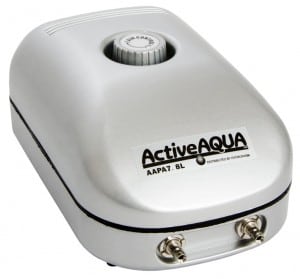LOW-OUTPUT AIR PUMPS
Super silent with multi-level muffler.Features
– Super silent with multi-level muffler
– Special artificial rubber to keep a steady air flow output and pressure that can be adjusted freely (except single outlet)
– Low power consumption
– Pressure >3.768 psi
– Adjustable air flow
Shipping Weight 1.4 lbs.
Package Dimensions 5.2L x 3.3W x 7.9H
Warranty 1 Year
Rated LPM 7.8
Voltage 120
Rated Wattage 3
Rated GPH 125
Rated Amperage 0.025
Max. Decibels 40
Instructions for Operation:
1. Remove the air pump from the packaging and twist tie from the power cord.
2. Gather the desired ¼” diameter air tubing and stone (diffuser).
3. Mount the air pump unit on a stable dry surface above the water level near a 120v power
source.
4. Connect one end of the air tubing to the air pump outlet, and the other end of the air tube to
the air stone (diffuser).
5. Place the air stone in the desired location of the nutrient reservoir/tank/container or other area
where added oxygen supplementation is needed.
6. Plug the power cord of the air pump into a designated 120v outlet.
Special Notes and Instructions:
• Ensure the air pump unit(s) is above the water level of the reservoir or tank being oxygenated.
• Failure to do so may result in water back flowing through the air tube and damaging the pump.
• To increase air pressure to the available outlets adjust the power adjustment knob located on
the top of the unit housing.
• ¼” plastic tees may be used to increase the number of available outlets or increase the pressure
to a single stone.
• Remove any hair, dirt and debris that may accumulate on the air intake filter located on the
bottom of the unit.
Related Items
FAQ’s
Q: Does my air pump need to sit above water level?
A: Yes, this is very important for proper placement, otherwise you risk water back flowing through the air tubing and causing permanent damage to the pump.
Q: Can I use this pump outdoors?
A: These pumps are meant for indoor use only.
The Do’s and Don’ts of Brewing:
#1 Do use LOTS of oxygen!
A powerful air pump yields a powerful brew. Period. The beneficial organisms in your tea simply crave oxygen. It is impossible to use too much. Harmful, pathogenic organisms thrive in an anaerobic, or low oxygen, environment. Good compost tea will effectively colonize soil with an abundant population of beneficial microbes, fungi, and protozoa when “fueled” with large amounts of oxygen for 4 to 18 hours first. Low-oxygen brews will always create more opportunities for pathogens to flourish. Don’t give them the chance to gain a foothold. We recommend an air pump with an output of 45 liters of oxygen per minute or more. Your tea will also brew FASTER this way, offsetting any additional power usage.
#2 Do make quick use of your tea.
“Infuse it and use it”. Allowing fresh Boogie Brew to sit around and “peak” is all too easy a mistake and is counter-productive to effective soil colonization. To truly benefit from a good compost tea’s root zone enhancing qualities, it should be used immediately after brewing. Try not to let your tea stagnate for more than two hours: Take advantage of all that bio-activity & drive fresh life into your soil ASAP!
#3 Don’t use chlorinated water!
Unfortunately chlorine and chloramine compounds are used in almost all municipal water systems and thus the use of an effective filter is required for creating quality compost tea. This is due to chlorine’s functional elimination of all bacteria, including the beneficial organisms that are alive and well in high quality compost, worm castings and other “live” amendments found in good tea recipes. Do continue to use de-chlorinated water on soil previously inoculated with live teas. Otherwise you will wipe out most of the beneficial biology you just introduced into your soil. You wouldn’t use antibiotics after cultivating acidophilus in the intestine from high quality yogurt cultures, would you? Use similar principles with compost tea for soil-success!
#4 Don’t forget to clean your brewer!
No matter how you infuse your Boogie Brew, it is imperative that you clean the container between brews. Otherwise there’s the risk of “bio-film” build-up and subsequent contamination. “Bio-film” is the layer of dead, organic material that is a natural result from the production of “exudates” from the billions of beneficial organisms flourishing in a healthy aerobic tea. As these organisms burst to life and begin to digest their food sources, (including the consumption of OTHER organisms), they “exude”, or give off, waste matter of their own. This exudate tends to collect wherever the billions of microbes living in a healthy tea are least active: i.e. the lining of your bucket or reservoir etc! If this layer of dead bio-film is not vigorously brushed clean between brews, it will contaminate and degrade the quality of new tea.
#5 Don’t mix synthetic fertilizers with your tea!
Ideally, infuse your soil with fresh tea only when you are applying your brew. Think of Boogie Brew as both a mild organic food source for your plants and at the same time a beneficial soil drench or biological “flush”. Some folks like to tinker with their teas and that is fine, as long as you don’t overdo it. Any sources of nutrition in your reservoir should be well-diluted and organic in nature. Don’t mess with success. Use natural ph adjusters if necessary, like citric acid/vit. C crystals, and apply to tea only AFTER brewing.
#6 Do practice good gardening!
That means sensible watering techniques, (don’t overwater!) as well as the intelligent use of organic fertilizers and non-toxic pest control whenever possible. Regard your plants and the soil they live in as a beautiful reflection of the symbiotic relationships of all living things. Modern science has shed much light on the intertwined and complex interactions that occur within a healthy soil-food-web, yet there is so much more that we still don’t fully understand. Respect those secrets and nurture your soil in the same manner you would revere the delicate balance and nature of life itself. Remember that compost tea’s miracles allow for far greater absorption and utilization of food/water sources. Be gentle. -Josh
Warnings
DO NOT SUBMERGE.
• Avoid direct contact with water to the unit or electrical components,
failure to do so may result in electric shock.
• Prevent pump motor burn out by ensuring adequate air flow around the unit.

